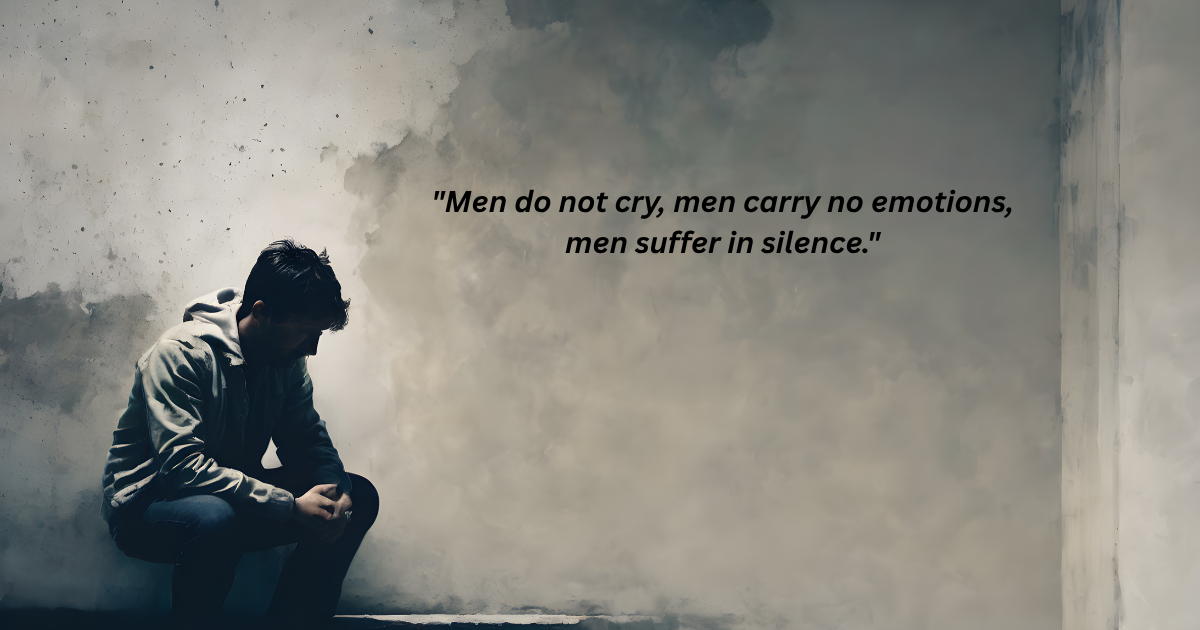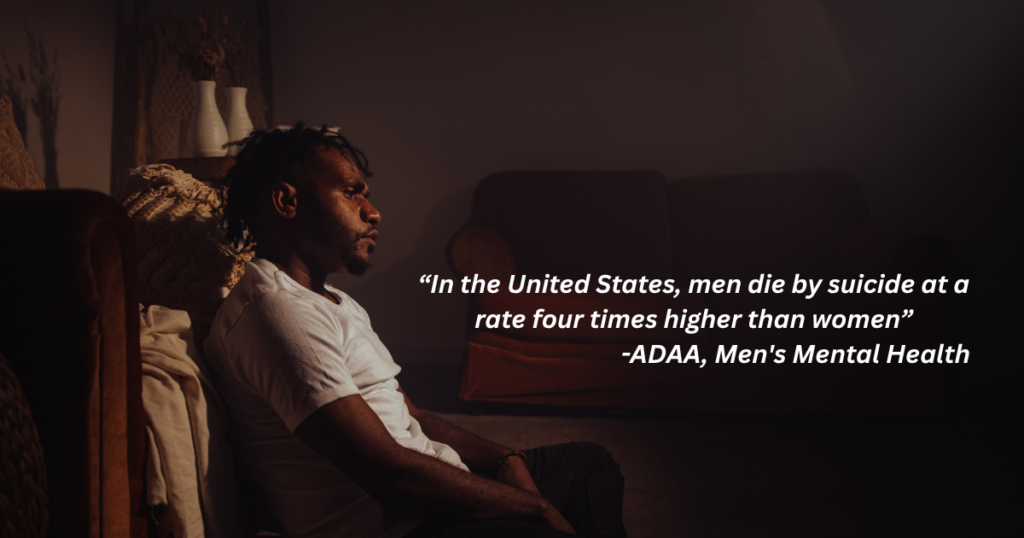What if the one thing society tells men is their greatest strength is actually their biggest weakness?
For generations, men have been taught to be strong, stoic, and independent. We’ve been conditioned to believe that showing emotion is a sign of weakness, and that the only acceptable response to pain is to “man up” and “tough it out.” This cultural conditioning has created a silent crisis, a hidden epidemic where men are suffering in isolation.
The numbers are stark and demand our attention. Men die by suicide at a rate three to four times higher than women [1]. This devastating statistic reveals a profound disconnect: a crisis of silence that is literally killing our fathers, brothers, sons, and friends.
This article is a call to action. It is a guide to understanding why this crisis exists, how to recognize the signs of struggle that often hide behind a façade of strength, and, most importantly, how to break the silence and redefine what true strength looks like.
The Stigma That Silences: Why Men Don’t Talk
The primary barrier to men’s mental health is the pervasive stigma rooted in outdated ideas of masculinity. The cultural script is clear: “Men do not cry, men carry no emotions, men suffer in silence.”
The Myth of the Stoic Man
This pressure to be the “stoic man” is a heavy burden. It forces men to build emotional walls so high that no one, not even they themselves, can see the pain inside. This is the core of “toxic masculinity” a set of cultural norms that equates emotional expression with femininity and weakness.
The personal stories of men who have struggled highlight this perfectly. One man, Allan Kehler, shared his journey from being an alcoholic gambler to finding his true self, realizing that mental health should not have a barrier of gender or stigma [2].
He, like many others, spent years hiding behind shame and embarrassment, burying his emotions because he felt he had no idea how to talk about his pain.
Vulnerability is Not Weakness
For many men, the statement, “I’d rather die than ask for help,” sadly rings true. This attitude is a direct consequence of a society that has wrongly framed vulnerability as a flaw.
When Murray, a man interviewed by Kehler, was given an ultimatum to seek help, he initially chose the door. It took a few lonely nights to realize he needed his family and needed help. When he finally reached out, he was met not with the judgment he feared, but with compassion and understanding [2].
This is the essential truth we must embrace: vulnerability is, in fact, strength. It is the courage to be honest about your internal state, and it is the first step toward genuine healing.
Recognizing the Signs: Depression Doesn’t Always Look Like Sadness
One of the most dangerous aspects of the men’s mental health crisis is that depression in men often does not look like the textbook symptoms of sadness and withdrawal. Instead, it manifests as a “pressure cooker” effect, where bottled-up emotions find external, often destructive, outlets.
The Externalized Symptoms
When men are taught to suppress feelings of sadness or hopelessness, those emotions often transform into more socially acceptable yet equally damaging behaviors.
| Symptom Category | Male Manifestation | Underlying Emotion |
|---|---|---|
| Anger & Irritability | Road rage, short temper, lashing out at loved ones, increased aggression. | Unexpressed sadness, frustration, or feeling out of control. |
| Escapism & Risky Behavior | Increased alcohol or drug use, compulsive gambling, reckless driving. | Attempt to numb emotional pain or seek a temporary high to mask low mood. |
| Withdrawal | Isolating from friends, canceling social plans, spending excessive time alone. | Shame, fear of judgment, or emotional exhaustion. |
| Overworking | Obsessive focus on career or hobbies to the exclusion of everything else. | Distraction from internal pain; seeking self-worth through external success. |
Research from the Harvard Business Review identifies these coping mechanisms: escapism (men are three times more likely to drink alone), withdrawal, and externalization [3].
These actions are often seen as “bad behavior” rather than symptoms of a mental health issue, leading to a tragic delay in seeking help [4].
Read Also: Shining a Light on Depression: Understanding, Coping, and Finding Hope
The Physical Toll
The mind and body are deeply connected, and emotional distress often presents as physical pain. Men frequently report symptoms like persistent headaches, chronic body aches, and overwhelming fatigue.
One man, a lawyer, shared how his anxiety manifested physically: he would go to the bathroom and throw up from anxiety before going back to his desk to work [3].
Another man’s wife observed that he would physically react to stress by throwing up before work a clear sign of emotional distress that was initially misunderstood [3]. These physical symptoms are often the body’s way of screaming for help when the voice has been silenced.
The Tragic Cost of Silence: Statistics That Demand Action
The data surrounding men’s mental health paints a clear picture of a public health emergency. The silence is not just uncomfortable; it is lethal.
The Suicide Disconnect
The most alarming statistic is the male suicide rate. In the United States, men die by suicide at a rate four times higher than women [1]. Globally, the rate of suicide deaths for men is more than double the rate for women [6].
This is compounded by a diagnostic disconnect: women are statistically twice as likely to be diagnosed with depression, yet men are twice as likely to die by suicide [4]. This contradiction is a critical flaw in our approach to mental health.
The Contradiction in Data
A PhD researcher noted that while data often shows young, unmarried white women reporting the worst mental health, the suicide statistics tell a different story: men, ethnic minorities, and migrants suffer disproportionately but often say they’re “fine” [4].
This culture of stoicism saying “I’m fine” when we’re not distorts our understanding of who needs help. Because men are less likely to verbalize feelings of sadness or low self-esteem, they often fall outside the traditional diagnostic criteria, leading to their struggles going unnoticed and untreated until they reach a point of total collapse [4].
| Mental Health Metric | Women | Men |
|---|---|---|
| Depression Diagnosis | ~2x more likely to be diagnosed | Less likely to be diagnosed |
| Suicide Rate | Lower rate | 3-4x higher rate |
| Symptom Expression | Internalized (sadness, withdrawal) | Externalized (anger, aggression, substance abuse) |
| Seeking Treatment | More likely to seek help | Less than half receive treatment [1] |
It’s Everyone’s Issue
When 75% of all suicides in North America are men, this is not just a “men’s issue” it is a societal issue that affects everyone [2]. These are our sons, our brothers, our partners, and our friends. We all have a role to play in challenging the gender stereotypes that chain men to silence.
Also Read :Mastering Anger: Understanding & Managing Emotional Storms
The Path to Healing: Redefining Strength and Taking the First Step
Healing begins when the desire to heal becomes stronger than the need to appear strong. The path forward requires a fundamental shift in how men view themselves and how society supports them.
The Power of Vulnerability
The most powerful tool for change is the simple act of talking. Vulnerability sparks connection, and connection fuels healing.
One man who found his way out of crisis shared a profound moment in a support group. When he finally broke down, the only other man there looked at him and said, “It’s okay, my friend. I get it.” Those simple words saved his life [2]. This is the power of shared experience: it reminds us that we are not alone.
Creating Safe Spaces
For those who love a man who is struggling, the approach can be simple, but it must be genuine. The goal is to create a safe space without judgment.
The best approach is to listen, not to fix. If you are concerned about a friend or loved one, you can simply say: “I don’t mean to pry, but I just want to let you know I’m concerned. If you ever need to talk, I’m here to listen.” [2]
This simple statement tells someone, “I see you,” and gives them permission to be heard. When they finally do reach out, remember the golden rule: we have two ears and one mouth for a reason to listen twice as much as we speak.
Small Lifestyle Changes, Big Impact
While professional help is crucial, small, consistent changes in daily life can build a foundation for better mental health.
- Physical Activity: Movement releases endorphins that boost mood. Even a brisk walk or a simple commitment to the gym can make a difference. Invite a friend to join you it combines physical activity with social connection.
- Reduce Substance Use: Alcohol and drugs are temporary escapes that ultimately worsen depression. Reducing intake is a critical step, as alcohol’s depressive effects can make emotional struggles feel heavier.
- Real, Offline Social Connections: Loneliness is a major contributor to mental health decline. Being physically around others reduces isolation and helps men feel grounded. Prioritize face-to-face time with trusted friends.
- Practice Self-Awareness: Start by simply acknowledging your feelings. Instead of putting a “cork on the bottle” of emotion, as one man described his coping mechanism, allow yourself to feel it [6]. This self-awareness is the first step toward self-care.
Read Also: Top Development Activities for Self-Improvement
Professional Help is a Sign of Courage
Seeking professional help is not a failure; it is an act of courage and self-preservation. It means you are taking control of your health.
- Primary Care Physician: Your doctor is a good place to start. They can perform initial screenings and refer you to specialists.
- Mental Health Professionals: Specialists like therapists, counselors, and psychiatrists can provide support, diagnosis, and treatment tailored to your needs.
- Support Groups: Groups like Alcoholics Anonymous, Gamblers Anonymous, or bipolar support groups offer a powerful sense of community where men can hear their story through others and realize they are not alone [2].
Essential Resources: You Are Not Alone
If you or someone you know is struggling, please know that help is available immediately. Reaching out is the hardest step, but it is the most important one.
Immediate Crisis Support (24/7)
These resources are free, confidential, and available around the clock.
| Country/Region | Resource | Contact Information |
|---|---|---|
| United States | 988 Suicide & Crisis Lifeline | Call or Text 988 |
| United Kingdom | Samaritans | Call 116 123 |
| Global | Crisis Text Line | Text HOME to 741741 |
Men-Specific Support Organizations
These organizations are dedicated to supporting men’s mental health and challenging the stigma.
- HeadsUpGuys: A leading men’s mental health site with expert-backed tips, self-checks, and recovery stories [7].
- Man Therapy: Provides men with tools and resources to deal with tough situations in a way that resonates with them [8].
- CALM (Campaign Against Living Miserably) – UK: A movement against male suicide, offering a helpline and webchat for men [9].
- MensLine Australia: A 24/7 telephone and online counseling service for men with emotional health, mental health, and relationship concerns [10].
In this talk, a speaker opens up about how societal expectations of masculinity silence men’s emotional struggles and hinder their mental health.
Conclusion: A Call to Action for a Healthier Future
The silent crisis of men’s mental health has gone on for too long. We have seen the tragic cost of outdated ideals that equate silence with strength.
To move forward, we must redefine masculinity. True strength lies not in stoicism, but in self-awareness, empathy, and the courage to be vulnerable. Healthier men build healthier relationships, families, and communities.
Every man who reaches out, every man who shares his story, and every person who listens without judgment is a hero in this movement. We must create a culture where men feel safe to talk, share, and be vulnerable.
The conversation around men and mental health will not get better unless we make it better.
Together, we can end the silent crisis of men’s mental health one conversation, one story, and one man at a time.
Disclaimer: This article is for informational purposes only and is not a substitute for professional medical or mental health advice. Always seek the guidance of a qualified health professional with any questions you may have regarding your health or a medical condition.
Frequently Asked Questions (FAQs)
Q: Why is men’s mental health often called a “silent crisis”?
A: It is called a silent crisis because men are culturally conditioned to suppress emotions and “man up,” leading them to suffer in isolation. This silence results in men dying by suicide at a rate 3-4 times higher than women.
Q: How does depression in men differ from depression in women?
A: Men often express depression through externalized symptoms like anger, irritability, substance abuse, and risky behavior, rather than the sadness and withdrawal more commonly seen in women. This difference often leads to misdiagnosis or no diagnosis at all.
Q: What are the most common signs of mental health issues in men?
A: Common signs include increased anger, excessive drinking or drug use, isolating from friends and family, and physical symptoms like chronic headaches or fatigue. Overworking or engaging in reckless behavior can also be a sign.
Q: Why do men avoid seeking help for mental health problems?
A: The primary reason is the stigma that equates emotional vulnerability with weakness, a concept rooted in outdated ideas of masculinity. Many men fear judgment, shame, or being seen as less competent if they admit to struggling.
Q: What is the best way to help a man who is struggling?
A: The best approach is to listen without judgment and avoid trying to “fix” the problem. Offer a safe space by saying, “I’m concerned, and I’m here to listen if you ever need to talk.”
Q: Is seeking professional help a sign of weakness?
A: Absolutely not. Seeking professional help is an act of courage and self-preservation, demonstrating a commitment to taking control of one’s health and future. It is a sign of true strength.
Q: Where can I find immediate help if I or someone I know is in crisis?
A: For immediate help, call or text the 988 Suicide & Crisis Lifeline in the US, or call 116 123 for Samaritans in the UK. You can also text HOME to 741741 for the Crisis Text Line.
References
[1] ADAA. Men’s Mental Health. https://adaa.org/find-help/by-demographics/mens-mental-health [2] Kehler, A. (2022). Mental Health Crisis in Men. TEDxDalhousieU. [https://www.youtube.com/watch?v=jzD8-LeESDU]
[3] Parsons, C. (2021). Mental Wellbeing: My Story. TEDxILSLaw. [https://www.youtube.com/watch?v=MqSYsVsLvQ0]
[4] Murray, A. (2022). The Silent Crisis of Men’s Mental Health. TEDxUniversityofGlasgow. [https://www.youtube.com/watch?v=A-1_h8w4f6g]
[5] Harvard Business Review. Men’s Mental Health: What Are They Doing Instead? (Reference to research cited in user content)
[6] AAMC. Men and mental health: What are we missing?. https://www.aamc.org/news/men-and-mental-health-what-are-we-missing
[7] Wikipedia. List of countries by suicide rate. https://en.wikipedia.org/wiki/List_of_countries_by_suicide_rate
[8] HeadsUpGuys. Men’s Mental Health and Suicide Prevention. https://headsupguys.org/
[9] Man Therapy. Men’s Mental Health Resources. https://mantherapy.org/
[10] CALM. Campaign Against Living Miserably. https://www.thecalmzone.net/
[11] MensLine Australia. 24/7 Counselling Service. https://mensline.org.au/




